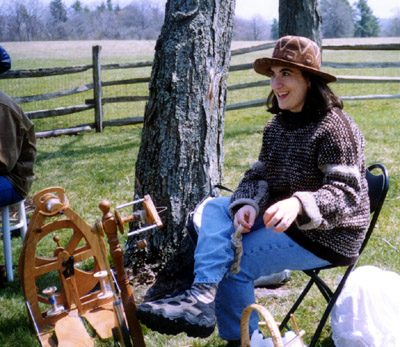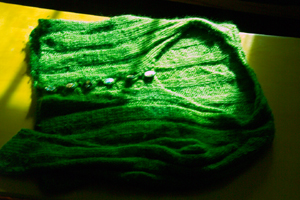When the temperature
drops each fall, I open my cedar hope chest
and dive into my sweaters. A majority are
hand knit and I'm seized by their individual
sentimental meaning or their imperfections.
I return to some sweaters as old friends.
Here's the brown, slip-stitch one that I wore
on my first date with the man who is now my
husband. Next I find my "bus sweater",
a three-year project made out of cream-colored
counterpane triangles that became a masterpiece
when assembled. I embrace the old friend sweaters
even as they become worn and tired looking.
Those sweaters are carefully hand washed,
reshaped, and worn regardless of their age.
It's the other sweaters
that bother me. When I open the chest, I see
the brown, simple knit cardigan with the big
wooden buttons. Its flaw lies in the weird
fashion choices I made -- the big buttons
are still acceptable, but the short, almost
shrug-like length is not. It looks now like
I knit only half a sweater. Or the gray vest;
its abalone buttons nearly redeem it. The
vibrant natural gray from a friend's Romney
sheep make it worth keeping. But I never wear
it because the crocheted edges of the arm
holes look strange. I feel frumpy when I have
it on.
There are days when
I look just right in a sweater that I've made.
There are days when I look good in a store-bought
sweater that fits. However, I settle all too
often for a day at home with an old handspun,
hand-knitted sweater that makes me look rumpled
and unkempt. I'm too attached to the work
I've put into it to give up such a sweater,
but I'm not able to produce a perfect product
every time. Also, I come from a community
of fiber artists who give me others' mistakes,
and only occasionally do those sweaters fit.
Today I wear
my mother's creation, a long bright red car
coat which was so fascinating to knit that
I knew of two people knitting this pattern
at the same time. The coat never fit my mother.
In the past, when
everything was homemade, people made do. Garments
were often exchanged with family members or
friends until they found a good home on the
back of a wearer better suited to its design.
Clothes were remade over and over again. These
renovations enabled a sweater to become useful
even after the sleeves were damaged or the
cuffs torn. Sweaters became vests, and vests
became felted vests, until eventually knitted
fabric was sewn and cut into a child's sweater,
a pair of mittens, and a work scarf or hat.
I try to learn from our ancestors' ingenuity,
and salvage my mistakes.
More often than not,
I don't have the skills to do a seamless renovation
to an existing sweater. I am a contractor
sent in to do a tough job. I lack just the
right tool or architectural details. How to
make it look like the vest (now a sweater)
always had different color sleeves? How can
I make it look like the buttons were purposefully
mismatched? Sometimes, though, I score a victory
for innovation. My "new" sweater
has all the grace and style that the old sweater
lacked.

 Once,
I acquired a store-bought Shetland wool turtleneck
from a famous mail order catalog. It was light
heather gray, just the right thickness and
styling -- until I wore it. The overgenerous
turtleneck caused outrageous itching, regardless
of how tall a cotton turtleneck I wore beneath
it. I tolerated this neck irritation for years.
Finally, I gathered my courage and cut down
the turtleneck. I used knitting needles, a
yarn needle, and a glass of wine as extra,
false courage. I tacked down the edges to
make a crewneck sweater. This was an outstanding
victory for itchy necks everywhere. I plowed
ahead with confidence to my next project.
Once,
I acquired a store-bought Shetland wool turtleneck
from a famous mail order catalog. It was light
heather gray, just the right thickness and
styling -- until I wore it. The overgenerous
turtleneck caused outrageous itching, regardless
of how tall a cotton turtleneck I wore beneath
it. I tolerated this neck irritation for years.
Finally, I gathered my courage and cut down
the turtleneck. I used knitting needles, a
yarn needle, and a glass of wine as extra,
false courage. I tacked down the edges to
make a crewneck sweater. This was an outstanding
victory for itchy necks everywhere. I plowed
ahead with confidence to my next project.
On a trip to Britain,
I'd found some deliciously butter-colored
wool. It was from a rare breed of sheep called
Teeswater. It is practically impossible to
acquire this wool outside of the UK. The unspun
roving flew through my hands while I sat at
my spinning wheel, an intoxicating delight
to spin.
Then, I designed a
sweater for it, a concoction of ribs and eyelets
that fit like a Renaissance bodice, tight
in the sleeves and bust, accentuating my waist.
I chose buttons and my knitting needles soared
through the air like Mrs. Weasley's, somehow
enchanted to knit without ceasing. Half way
through the sweater, I got up to get a drink
of water, and returned to my senses. The deliciously
butter colored wool might look good enough
to eat, but it would look horrible on me,
with my dark hair and pale skin.

 Taking
a huge risk, I completed the sweater and dumped
it into a dye pot. Knowing that the dye take
up would be notoriously uneven and ugly, I
renovated with abandon. I used salt to slow
dye take up and slowly heated the water. At
the moment of truth, I hauled the sweater
out of the dyebath. It was a lovely spring
green with a yellow tinge which I knew would
make me look ill when I wore it. The renovation
wasn't working! In a moment of despair, I
threw a packet of blue dye into the mix. Magic
happened. I now own a blue splotched, kelly
green creation. The sweater's lustrous mohair-like
wool shines in the light and it receives compliments
wherever I go. This sweater is featured in
Belle Armoire, a wearable art magazine,
in their Winter 2004 issue. Its color is nothing
short of a miracle.
Taking
a huge risk, I completed the sweater and dumped
it into a dye pot. Knowing that the dye take
up would be notoriously uneven and ugly, I
renovated with abandon. I used salt to slow
dye take up and slowly heated the water. At
the moment of truth, I hauled the sweater
out of the dyebath. It was a lovely spring
green with a yellow tinge which I knew would
make me look ill when I wore it. The renovation
wasn't working! In a moment of despair, I
threw a packet of blue dye into the mix. Magic
happened. I now own a blue splotched, kelly
green creation. The sweater's lustrous mohair-like
wool shines in the light and it receives compliments
wherever I go. This sweater is featured in
Belle Armoire, a wearable art magazine,
in their Winter 2004 issue. Its color is nothing
short of a miracle.
This fall, I am faced
again with a chest full of sweaters. I envision
the renovations to come, but I am a procrastinator
when it comes to risk taking. I never work
on my old sweaters when the weather is warm
and sunny. On snowy days, when the temperature
drops precipitously, I'll know what to do.
There is a long white cardigan with wooden
buttons that needs to have new cuffs knit
on, because I've worn off the old ones. The
brown shrug cardigan with the huge buttons
needs a make over. I foresee an empire waist
cardigan with a different-colored ruffle at
the bottom that extends it to a full-sized
garment. Finally, there is the unknown future
to consider, a last-minute, spontaneous transformation
that will occur, when I desperately need a
change in February. Some sweater from the
bottom of the chest will get an overhaul,
and my creativity will emerge in sweater form,
like a butterfly from its chrysalis.

